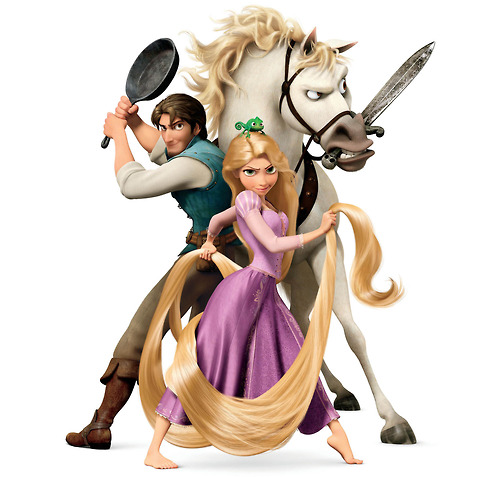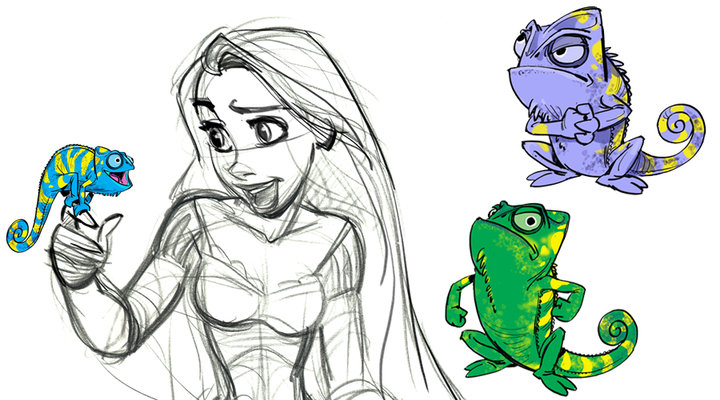Interview: Glen Keane of ‘Tangled’
Posted on November 24, 2010 at 6:28 pm
 Glen Keane is the man behind some of Disney’s most beloved animated films, including “Tarzan,” “Beauty and the Beast,” and “Aladdin.” As producer of the latest Disney movie, “Tangled,” he guided the project for more than fourteen years. It was an honor to have the opportunity to ask him about some of what went into making the film. We talked about what makes animation special, why the hair was the biggest challenge, and why Disney heroines always have cute animal sidekicks.
Glen Keane is the man behind some of Disney’s most beloved animated films, including “Tarzan,” “Beauty and the Beast,” and “Aladdin.” As producer of the latest Disney movie, “Tangled,” he guided the project for more than fourteen years. It was an honor to have the opportunity to ask him about some of what went into making the film. We talked about what makes animation special, why the hair was the biggest challenge, and why Disney heroines always have cute animal sidekicks.
My husband and I are both huge animation fans.
There is something about animation that really sinks in deep, isn’t there?
Years ago, at a preview of what was in the Disney animation pipeline, I saw some very preliminary concept sketches for this film and it was completely different from the finished film both in look and storyline. Can you tell me a little bit about how the movie evolved?
I started developing this story in ’96 while I was doing “Tarzan” and “Treasure Planet” and then started to work on it in 2002 full-time. At that point, the studio was looking for more of a twist on the fairy tale. That was the way the wind was blowing and I put up my sails and blew in that direction. That version was called “Rapunzel Unbraided” and I worked on it for three years. It was a fun, wonderful, witty version and we had a couple of great writers. But in my heart of hearts I believed there was something much more sincere and genuine to get out of the story, so we set it aside and went back to the roots of the original fairy tale.
I know one thing that is very hard to animate is hair. In this movie, the hair is like a character of its own. How hard was that to do?
There’s 140,000 individual hairs and hair is the hardest thing to animate in a computer. It’s made up of pixels that bounce against each other. We did early tests. The hair reacted individually with a mind of its own like marbles dropping on a tile floor, the hair would just scatter in every direction. How in the world are we going to figure this out? We’ve been solving artistic problems with mathematics for six years on this film just trying to establish control. We broke it down to 147 different tubes each with a thousand hairs in it. There were much smarter people than I figuring out how to control it. My job was telling them what we wanted it to do. We needed to have rhythmic curves, we needed volume, we needed to twist it, we need to have individual hairs break out. The hair was the most complex character we had in the film.
Probably the most difficult scenes to do were the ones where she was just absent-mindedly touching her hair, the ones you just take for granted. I encouraged the animators to let Rapunzel touch her hair. The computer folks were like, “This is going to be big trouble!” But I told them no one would believe it if she couldn’t touch her hair.
One of the highlights of the film is Rapunzel’s little chameleon friend, Pascal. 
At first we did not have a sidekick. We thought, we’ve done sidekicks before, we don’t need to do it again. And then you realize why you need one. She’s alone in the tower! There’s so much going on in this girl’s mind and if you don’t have her talking to someone you don’t know what she’s thinking. At one point we had her talking to these little objects with personalities but you could start to think she might be crazy.
The little chameleon gave us an feeling of color. He could blend into different paintings and it just fit the idea of this girl who is an artist. It also fit with the idea that he’s just a tiny little character but he always helps Rapunzel take a step further.
You made the male character a much more important and interesting part of the story than he was in the fairy tale.
We had to find the right person to come into the tower. In the original fairy tale, it’s a prince. It’s a lot more interesting to have this girl where her mother is telling her that the outside world has got all these bad people and that what she lets come into the tower is truly a bad person. That makes it a much more interesting story and that was the goal in having this guy have a more colorful background.
I loved the character of the horse and the way his loyalties shift.
He’s the super-cop; he’s tough. Originally, that character was a dog. I had a heart attack in 2008 and stepped back from directing. The new directors took the dog and made it a horse. I was like, “No! You can’t take out the dog!” But it was even better; they had the personality of the dog and the attitude of someone so intent on getting Flynn. He was the ultimate sleuth — and it gave us a chance to take this character who was so dedicated to catching Flynn and have Rapunzel tame him. We were looking for ways that Rapunzel could show the transforming power that she has with the horse, with the thugs in the pub, with the people in the town that she gets to dance with her, and ultimately with Flynn himself.
You gave it a contemporary feeling without getting snarky. It has a lot of heart. How do you keep that balance?
A lot of that is the sensibility of Byron Howard and Nathan Greno, who have this really, really, deep, deep love of the sincerity of Disney films. At the same time, they have an irreverence and a clever sense of humor. They’re always pushing to make it a little bit funnier. We would re-animate scenes a dozen times over, just making it funnier, funnier, funnier. If it was a little laugh, that wasn’t enough. At once point Flynn in the pub is surrounded by thugs who tell him to sing and he says, “Sorry boys, I don’t sing. Suddenly, he is surrounded by swords and we cut to him singing and dancing. Byron says, “I don’t think he should turn his head.” It was funnier. He said, “I don’t think he should look at the swords at all.” And it was even better.
What do you love most about this story?
I love the idea of this girl with this incredible potential being kept back. The more you hold somebody back from who they’re meant to be, the more they have to get out and share it. There was enormous drive in getting that message out. I’ve always felt that hand-drawn has something so wonderful and can affect computer animation in a new way. This whole film was about taking the best of both worlds, infusing the best of hand-drawn and the best of computers. I want to continue to take hand-drawn to a whole new level, to have computers celebrate the artistry of drawing.

Great interview. Thank you both!